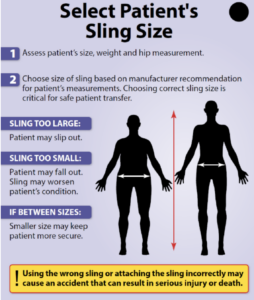Transfers Using Mechanical Aids: Overview

Many times you will be caring for clients that cannot assist you transferring them because they cannot bear weight. Mechanical lifts are safe solutions used to move a client from one position or place to another. Most often when working for an agency, they will likely have a no-lifting policy in place. A no-lifting policy means healthcare providers are not to manually try to lift a client, as this may cause serious injury to the client and/or care provider. Wherever you are employed, be sure you know the policy related to lifting clients!
Mechanical lifting equipment may vary from agency to agency, but the principle in their use is very similar. However, knowing how to use one does not mean you will know how to use other types. You should follow the agency procedures and know the instructions of the equipment manufacturer.
Before using any mechanical lift equipment, be sure:
- You are trained in its use.
- The lift is in good working order.
- The client’s weight does not exceed the lift capacity.
- You have reviewed the client’s transfer plan (care plan).
- You have two people to carry out the lift.

Transfers Using Mechanical Aids
Depending on the risk assessment, the healthcare worker may choose to use a mechanical aid to assist with transferring a client. The following videos provide some general direction to do this. It is the HCA’s responsibility to be oriented to the equipment they are working with and always use it in a safe manner.
Watch the following videos on Transfers Using a Mechanical Lift developed by Thompson Rivers University – School of Nursing
| Type of Sling | Indications for Use |
| Universal slings |
|
| Hammock slings |
|
| Hygiene slings |
|
| (Data source: Stewart, 2018) |
Special Considerations
- All mechanical aids have weight restrictions. Check your agency equipment and guidelines.
- All equipment has specific manufacturer’s guidelines for use.
- It is the agency’s responsibility to provide resources for orientation to use all equipment.
- It is the healthcare worker’s responsibility to be oriented to the use of all equipment being used.

- When using a ceiling lift, provide the rationale for your choice of the type of sling you should use when: (a) transferring a client to a shower chair; (b) transferring a client to a wheelchair.
Healthcare providers are not to manually try to lift a client as this may result in serious injury to the client and/or care provider

